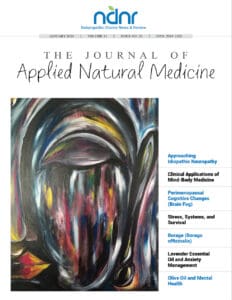Ashley Weber, HBSc, ND
Atopic dermatitis (AD), also called eczema, is an inflammatory, pruritic skin condition associated with immune dysfunction and altered skin barrier function.1 Prevalence is highest among children, at 10-20%, with 60% of cases beginning within the first year of life.1 Signs and symptoms include a pruritic, erythematous rash, which may present as dry or thickened skin with excoriations. Patients presenting with pyoderma often have a secondary bacterial infection which may require antibiotics. Location of AD in infants typically begins on the scalp (“cradle cap”), face/cheeks, or extensor surfaces of arms and legs; however, it may present at any location.2 It is important to check behind the ears, back of the neck, and in folds of skin in any infant suspected of AD. Risk factors for development of atopic dermatitis by 6 months of age include male gender, family history of atopy (asthma, eczema, allergic rhinitis), Black or Asian ethnicity, increased gestational age,3 and living in urban areas.4
Associated Factors
Atopic dermatitis in infants is often accompanied by gastrointestinal conditions such as infantile colic, gastroesophageal reflux, and/or constipation, although this connection is largely ignored in medical literature. Underlying dysbiosis of gut microbiota gives rise to a multitude of digestive symptoms and can lead to altered immune function, contributing to AD. Treatment of the common fundamental cause often leads to resolution of multiple symptoms.
Symptoms of AD often begin or flare up during solid food introduction, an important indication of possible food sensitivity, to be discussed in greater detail below. Additionally, AD often aggravates during tooth eruption, due to skin irritation from excessive drooling and systemic inflammation. Keep this in mind when flare-ups occur, and ease teething symptoms while continuing treatment for AD.
Treatment
Atopic dermatitis is a common condition in pediatric health, and although generally not a serious condition, it can be quite uncomfortable for babies and distressing for parents. Although similar principles apply when treating children and adults, treatment of infant AD requires unique routes of administration and altered doses. The following section reviews prevention strategies and treatment for uncomplicated infant atopic dermatitis.
Breastfeeding
Exclusive breastfeeding has numerous benefits, including decreased risk of atopic dermatitis, especially in those with a family history of atopy.5 It is important to reinforce this as a benefit to parents concerned about atopy or with a family history of AD. It is important for naturopathic physicians to provide the support and resources required in the face of difficulties with breastfeeding to ensure continuance.
Food Sensitivities
The role of maternal antigen avoidance and delayed food introduction for various conditions has been controversial in medical research. However, as naturopathic physicians, it is difficult to deny the clinical significance of food sensitivities. Recent evidence suggests that antigen avoidance during pregnancy does not reduce risk of AD, but that avoidance during breastfeeding may be beneficial.6 For infants that have already begun food introduction, removing common allergens as a part of treatment is helpful. Important food allergens in AD include cow dairy and egg, among others.7 It is also necessary to educate parents on appropriate methods of solid-food introduction and awareness of signs of reaction. If AD flares with introduction of a new food, it is appropriate to remove the food for a period of time and attempt introduction again at a later date. Such foods may be better tolerated once other factors contributing to AD are addressed.
Probiotics
One mechanism for development of AD is altered immune function, with suppressed Th1 function and heightened Th2 activity. A significant body of evidence has shown that probiotics modulate Th1/Th2 response, which can help to prevent allergic conditions such as AD.8 Recent studies have shown that probiotics during pregnancy and breastfeeding significantly reduce the incidence of infant AD.9-12 Doses and strains used in such studies are inconsistent, which contributes to varied results; however, a recent large-scale meta-analysis concluded that the combination of Lactobacillus (rhamnosus10 or ruteri11) and Bifidobacterium to be most effective.12
Similarly, evidence for probiotics supplemented directly to infants as treatment of AD is also conflicting; however, numerous studies do show significant benefit.13-14 Selection of specific probiotic strains at appropriate doses for pregnant breastfeeding mothers and infants, in order to shift towards Th1, aids in prevention and treatment of atopic dermatitis in infancy.
Vitamin D
Vitamin D has immunomodulating properties and may therefore play a role in treatment of atopic dermatitis; vitamin D deficiency has also been associated with increased risk of childhood AD.15 Maternal supplementation with vitamin D during pregnancy is associated with significantly increased cord blood vitamin D status, and subsequent reduced risk of AD.16 It has also been shown that vitamin D deficiency in older children is linked to increased risk of AD, and that repletion of vitamin D status improves symptoms;17 however, trials conducted during breastfeeding and infancy are lacking. Due to safety and widespread beneficial effects of vitamin D, supplementation during pregnancy, and possibly breastfeeding and infancy, at appropriate doses is beneficial for prevention and treatment of AD.
Essential Fatty Acids
Etiology of AD and its association with omega-3 and omega-6 fatty acids have been investigated with conflicting evidence, however are worth consideration. Fish or fish oil consumption during pregnancy has been repeatedly shown to reduce incidence of AD of infants,18 and similar results have been shown in breastfeeding.19 Supplemental evening primrose oil (EPO) for children with AD has been shown to be effective for symptom reduction,20 while similar research for fish oils in children with AD shows lack of effect. It is therefore warranted to consider maternal fish oil supplementation during pregnancy and lactation, with the possible addition of EPO in infancy, depending on age, for treatment of AD.
Homeopathy
Homeopathic remedies are an excellent adjunct to treatment of AD in infants, and remedies often change throughout the course of treatment. To give remedies to infants, crush pellets between 2 spoons, and place them inside their mouths. Some practitioners dissolve pellets in water, which is also effective. A wide variety of remedies may be indicated; the following is a sample of keynotes:
- Arsenicum – Very dry and flaky skin. Very itchy, scratches until raw. Uncovered areas of skin worst. Worse after midnight, cold air. Better warm air and hot bath.21-22
- Graphites – Dry with honey-like discharge that crusts over. Slow to heal. Deep cracks in skin. Location: scalp, hairline, behind ears, skin folds, genitals, backs of hands. Worse at night and heat. Better cold applications.21-22
- Petroleum – Extremely dry, almost painful. Red, raw, and moist skin surface, which oozes after scratching. Bleeds easily and becomes infected. Scratches until bleeds. Location: palms, fingertips, joints, genitals. Worse winter and cold air. Better warm air and dryness.21-22
- Sulphur – Most common remedy for eczema. Dry, scaly, cracked areas of skin. Intense itching. Scratching until raw or bleeding. Location: hairline, face, elbows and knees. Worse night, heat, warmth of bed, and wool. Better dry, cool bathing.21-22
Topical Applications
Although AD must be treated internally to address the root cause, topical applications are useful for symptom management, and aid in skin healing. Maintaining moisture of skin is imperative, so use appropriate oils or safe creams.
- Aloe vera – Aloe gel is intensely moisturizing and used for dry skin. For some patients, treatment with aloe topically may provide enough hydration to allow skin to heal naturally.23
- Calendula officinalis – Calendula has anti-inflammatory, vulnerary, antipruritic, and antimicrobial properties when used topically. Typically used for more severe AD that requires wound-healing.23-24
- Stellaria media – Chickweedhas vulnerary and strong anti-pruritic properties when used topically, and is indicated especially in cases of intense itching.24
- Azadirachta indica – Neem is used topically for intensely dry skin, and has anti-inflammatory and anti-pruritic properties, which may partially be explained by its quercetin content.24
Conclusion
Although atopic dermatitis is common among infants, it should not be viewed as “normal,” but rather a sign of deeper dysfunction. Many of the preventative measures used for AD have numerous other benefits for both mom and baby, and are easily incorporated into perinatal wellness plans. Treatment may vary depending on age of the infant and severity of symptoms; however, addressing the root cause and healing from the inside-out will have substantial benefit, not only on current symptoms of atopic dermatitis, but also prevention of related conditions in the future and overall health.
 Ashley Weber, HBSc, ND is a naturopathic physician and graduate of the Canadian College of Naturopathic Medicine. Prior to her medical studies, she obtained an Honors Bachelor of Science degree in kinesiology from McMaster University. In addition to private practice, she is co-founder of Samana Health Retreats, offering custom luxury retreats and programs focusing on holistic health and yoga. Ashley maintains a general family practice at 2 locations in Toronto, Canada, with a clinical focus and passion for prenatal health and pediatrics. To learn more, visit www.AshleyWeberND.com, or follow Ashley on Twitter at @AshleyWeberND.
Ashley Weber, HBSc, ND is a naturopathic physician and graduate of the Canadian College of Naturopathic Medicine. Prior to her medical studies, she obtained an Honors Bachelor of Science degree in kinesiology from McMaster University. In addition to private practice, she is co-founder of Samana Health Retreats, offering custom luxury retreats and programs focusing on holistic health and yoga. Ashley maintains a general family practice at 2 locations in Toronto, Canada, with a clinical focus and passion for prenatal health and pediatrics. To learn more, visit www.AshleyWeberND.com, or follow Ashley on Twitter at @AshleyWeberND.
References
- Watson W, Kapur S. Atopic dermatitis. Allergy Asthma Clin Immunol. 2011;7(Suppl 1):S4.
- National Eczema Association. Atopic Dermatitis in Children. http://www.nationaleczema.org/living-with-eczema/atopic-dermatitis-children. Accessed January 6, 2014.
- Moore MM, Rifas-Shiman SL, Rich-Edwards JW, et al. Perinatal predictors of atopic dermatitis occurring in the first six months of life. Pediatrics. 2004;113(3 Pt 1):468-474.
- Shram ME, Tedja AM, Spijker R, et al. Is there a rural/urban gradient in the prevalence of eczema? A systematic review. Br J Dermatol. 2010;163(5):964-973.
- Gdalevich M, Mimouni D, David M, et al. Breastfeeding and the onset of atopic dermatitis in childhood: A systematic review and meta-analysis of prospective studies. J Am Acad Dermatol. 2001;45(4):520-527.
- Kramer MS, Kakuma R. Maternal dietary antigen avoidance during pregnancy or lacation, or both, for preventing or treating atopic disease in the child. Cochrane Database Syst Rev. 2012;9:CD000133.
- Gaby AR. Nutritional Medicine. Condord, NH: Fritz Perlberg Publishing; 2011.
- Toh ZQ, Anzela A, Tang MLK, et al. Probiotic therapy as novel approach for allergic disease. Front Pharmacol. 2012;3:171.
- Rautava S, Kainonen E, Salminen S, et al. Maternal probiotic supplementation during pregnancy and breastfeeding reduces the risk of eczema in the infant. J Allergy Clin Immunol. 2012;130(6):1355-1360.
- Foolad N, Brezinski EA, Chase EP, et al. Effects of nutrient supplementation on atopic dermatitis in children: A systematic review of probiotics, prebiotics, formula, and fatty acids. JAMA Dermatol. 2013;149(3):350-355.
- Forsberg A, Abrahamsson TR, Bjorksten B, et al. Pre- and post-natal Lactobacillus ruteri supplementation decreases allergen responsiveness in infancy. Clin Exp Allergy. 2013;43(4):434-442.
- Dang D, Zhou W, Lun ZJ et al. Meta-analysis of probiotics and/or prebiotics for the prevention of eczema. J Int Med Res. 2013;41(5):1426-1436.
- Betsi GI, Papadavid E, Falagas ME. Probiotics for the treatment and prevention of atopic dermatitis: A review of the evidence from randomized controlled trials. Am J Clin Dermatol. 2008;9(2):93-103.
- Isolauri E, Arvola T, Sutas Y, et al. Probiotics in the management of atopic eczema. Clin Exp Allergy. 2000;30(11):1604-1610.
- Wang SS, Hon KL, Kong AP, et al. Vitamin D deficiency is associated with diagnosis and severity of childhood atopic dermatitis. Pediatr Allergy Immunol. 2014;25(1):35-35..
- Jones AP, Dip PG, Palmer D, et al. Cord blood 25-hydroxyvitamin D3 and allergic disease during infancy. Pediatrics. 2012;130(5):e1128-1135.
- Mutki K, Koo J. Update on the role of systemic vitamin D in atopic dermatitis. Pediatr Dermatol. 2013;30(3):303-307.
- Kremmyda LS, Vlachava M, Noakes PS, et al. Atopy risk in infants and children in relation to early exposure to fish, oily fish, or long chain omega-3 fatty acids: a systematic review. Clin Rev Allergy Immunol. 2011;41(1):36-66.
- Thijs C, Muller A, Rist L, et al. Fatty acids in breast milk and development of atopic eczema and allergic sensitization in infancy. Allergy. 2011;66(1):58-67.
- Chung BY, Kim JH, Cho SI, et al. Dose-dependent effects of evening primrose oil in children and adolescents with atopic dermatitis. Ann Dermatol. 2013;25(3):285-291.
- Hershoff A. Homepathic Remedies: A quick and easy guide to common disorders and their homeopathic treatment. New York, NY: Penguin Putnam Inc; 2000.
- Morrison R. Desktop Companion to Physical Pathology. Nevada City, CA: Hahnemann Clinic Publishing; 1998.
- Atopic dermatitis [database online]. Middlesex County, Massachusetts: Natural Standard, 2013. http://progressive.naturalstandard.com/databases/conditions/all/allergy-atopicdermatitis.asp? Accessed January 8, 2014.
- Hoffmann, D. Medical Herbalism: The Science and Practice of Herbal Medicine. Rochester, Vermont: Healing Arts Press; 2003.

